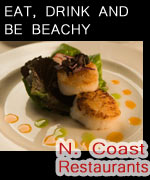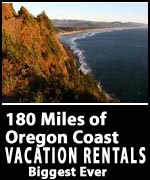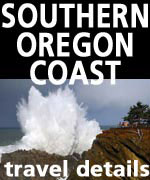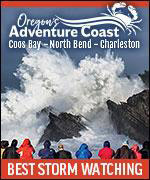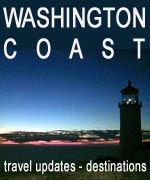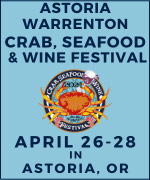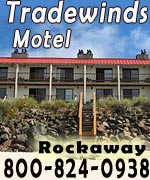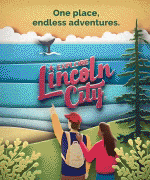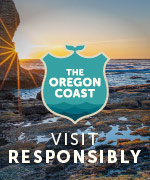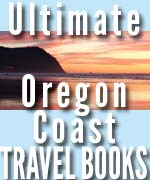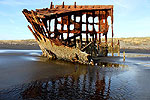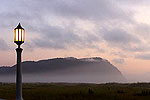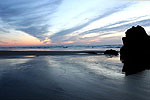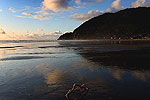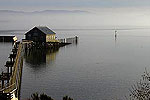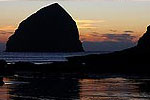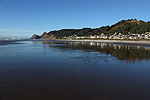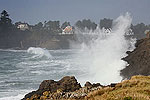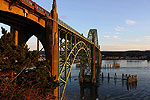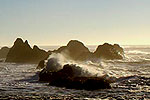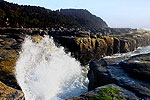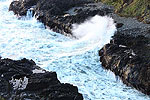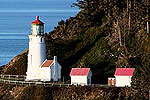String of Stunning Animal Sightings, Salp Finds on Oregon Coast
Published 01/13/2017 at 2:43 PM PDT - Update 01/13/2017 at 6:43 PM PDT
By Oregon Coast Beach Connection staff
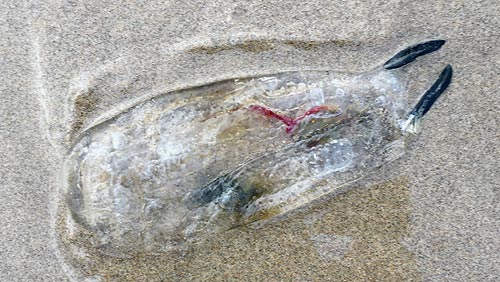
(Oregon Coast) – While Mother Nature is keeping potential visitors to the Oregon coast trapped in a deep freeze inland, she's also been quite the trickster lately. A somewhat new kind of salp has been spotted, an old face has returned and sea lions are amazing everyone along the beaches now. (Photo above: A new kind of salp found at Manzanita, photo courtesy Sue McGrath).
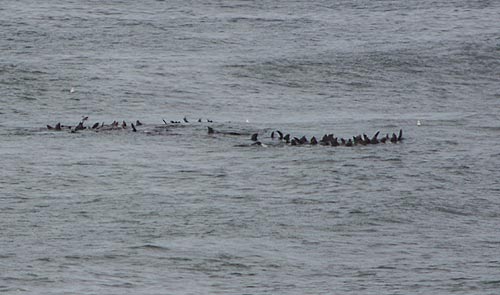
One of the biggest things making a “splash” along the Oregon coast is the sight of gobs of sea lions huddling together in unusual formations in the water. It's known as rafting, and it's a kick in the pants to observe. (Rafting photos courtesy Tiffany Boothe, Seaside Aquarium).
Tiffany Boothe of Seaside Aquarium said they've received many calls from all over the north Oregon coast about this. Other sightings include around Gleneden Beach and Lincoln City as well.
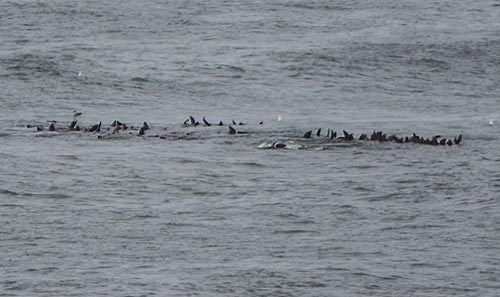
“Sea lions have been seen congregating together, en masse on the surface of the ocean, just outside of the surf zone,” Boothe said. “When sea lions do not want to haul out of the water, they use this tactic to sleep and rest. The protection of the group provides safety. We are probably seeing more of this due to the cold air temperatures. The ocean temperature is much warmer than the outside temperature at the moment, so the sea lions are probably just trying to stay warm like the rest of us.”
Perhaps the craziest find was made in Manzanita lately: a kind of salp that is very rarely seen washing up on the West Coast, although they are known to inhabit these waters to some degree. Its name is Thetys vagina: Thetys after a Greek mythological figure; and vagina from the Latin term for sheath (not the body part).
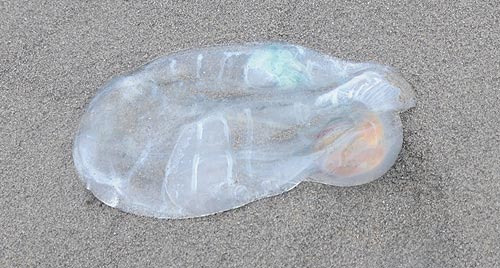
Thetys vagina salp photo courtesy Tiffany Boothe, Seaside Aquarium - note the lack of "rudders"
The one pictured at top was discovered in Manzanita this week by Oregon resident Sue McGrath.
Boothe said it is the largest known species of salp, getting up to 12 inches in length.
“They occur as either individuals or a connected colony,” she said. “The photograph you sent me is of an individual. The purple projections act kind of as a rudder.”
In their colonial state, Thetys salps don't have those rudders. Salps – just like the freaky pryosome form of salp found a lot recently – can form colonies that are comprised of dozens to hundreds of them, reaching several yards long. Even more dramatic, they do this by cloning themselves: replicating dozens of versions of themselves and then forming that chain. This happens at one stage of the creature's life, and then single bodies eventually start breaking away.
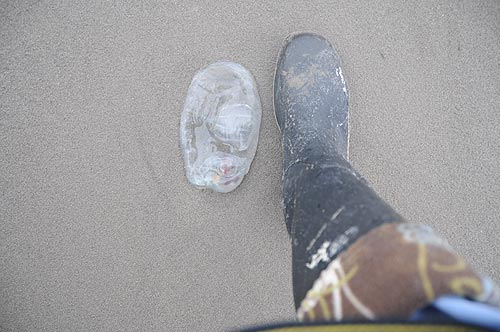
A salp is sort of related to a jellyfish, although it genetically has more in common with fish and people than with jellies. Salps are palaegic, meaning they drift along in the ocean. They can come in many, many forms, of which quite a few wash up on the Oregon coast.
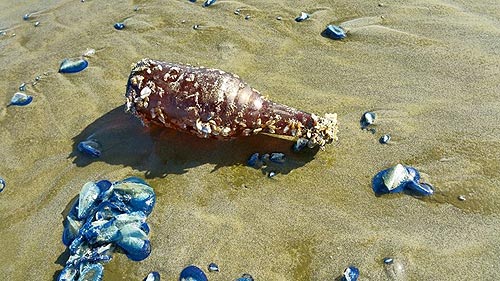
Velella velella, courtesy Tiffany Boothe, Seaside Aquarium
Increasingly familiar to these shores is the velella velella, a downright beautiful creature that has shown up on the Oregon coast in enormous numbers in the past, then mostly disappearing for a few years at a time. Boothe said they are back. She spotted a few recently on the north Oregon coast – a bit of a surprise as they tend to show up later in winter or spring.
“Locally, when the wind blows out of the west and the velellas are close to shore, the wind blows them onto our beaches,” Boothe said. “Winter velellas are much smaller than the ones that wash ashore in the spring and summer. Some are so small they hardly standout from a grain of sand.”
Velella velella are often confused as jellyfish, but they're really not even close. Like the pryosome salp, they too are made of dense colonies of other creatures, this time a tiny sea-faring animal called a hyrdozoa. The jellyfish-like creature called a Man-of-war is closely related to these, but they're just a much larger, single-bodied version of a hyrozoa. Oregon Coast Lodgings for this event - Where to eat - Maps - Virtual Tours
More About Oregon Coast hotels, lodging.....
More About Oregon Coast Restaurants, Dining.....
Cannon Beach Lodging
Nehalem Bay Lodgings
Manzanita Hotels, Lodging
Three Capes Lodging
Pacific City Hotels, Lodging
Lincoln City Lodging
Depoe Bay Lodging
Newport Lodging
Waldport Lodging
Yachats Lodging
Oregon Coast Vacation Rentals
Oregon Coast Lodging Specials
LATEST Related Oregon Coast Articles
Likely just before dawn best hour but peak happens during daylight. Weather
Dark Sky Week is Prime Along Oregon Coast: Where and Where Not to Go
General guide to dark sky viewing from south to north coast. Astronomy
Sizable Price Drop, Deals in Lincoln City During Quiet of April on Central Or...
20 perc off at A1 Vacation Rentals across its roster, including Gleneden Beach. Lincoln City specials
Upcoming S. Oregon Coast Events Include Gem Show, History: Coos Bay, Bandon
May 6 talk at Coos History Museum, Mayfly Fest May 17, Bandon Rock / Gem Show June 7,8
Washington Coast Cleanup on April 19 - Coinciding with Oregon Coast's SOLVE E...
From the Puget Sound to Long Beach, alongside Oregon's cleanup. Washington coast events, Seaside events
Astoria's Riverwalk Gets New Lighting, More N. Oregon Coast Roadwork
Delays coming this summer, but the riverwalk has a new look. Seaside, Cannn Beach
April Gets Even Cheaper Midweek at Depoe Bay, Lincoln City: Oregon Coast Deals
Off-season rates plus more at Keystone Vacation Rentals. Depoe Bay lodging specials, Lincoln City hotel reviews, Newport hotel reviews
Washington Coast Begins Week of Clam Digs, April 12 Through 18
Long Beach, Twin Harbors, Mocrocks and Copalis at different times. Washington coast events
Back to Oregon Coast
Contact Advertise on BeachConnection.net
All Content, unless otherwise attributed, copyright BeachConnection.net Unauthorized use or publication is not permitted




